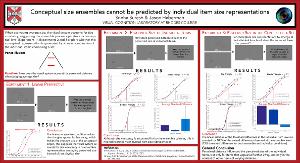Please use this identifier to cite or link to this item:
http://hdl.handle.net/10267/33462Full metadata record
| DC Field | Value | Language |
|---|---|---|
| dc.contributor.advisor | Haberman, Jason M. | - |
| dc.contributor.author | Suresh, Sneha B. | - |
| dc.date.accessioned | 2018-05-16T14:42:54Z | - |
| dc.date.available | 2018-05-16T14:42:54Z | - |
| dc.date.issued | 2018-04-27 | - |
| dc.identifier.uri | http://hdl.handle.net/10267/33462 | - |
| dc.description | Presentation by Sneha Suresh ('19) delivered at the Rhodes College Undergraduate Research and Creative Activity Symposium (URCAS). | en_US |
| dc.description.abstract | The visual system compresses redundant information into efficient, ensemble representations by averaging features across items. Ensemble perception operates with remarkable flexibility, even integrating object information at a conceptual level. For example, given a sufficiently strong depth cue, the visual system represents the perceived size of a set of triangles as opposed to their physical size (i.e., it accounts for size constancy; Suresh, Thomasson, & Haberman, VSS, 2017). In the current set of experiments, we explored whether conceptual ensemble size representation may be predicted by the size representation of the individual items composing the group. In every trial, observers viewed an individual triangle with and without linear perspective cues and judged whether a subsequently presented test triangle was larger or smaller than the preceding triangle. Whereas observers were biased to perceive the average size of multiple triangles as larger when presented in the context of linear perspective cues (i.e., conceptual size averaging), they did not take those cues into account when estimating the size of a single triangle. That is, observers perceived a single triangle in the context of linear perspective cues as the same size as a single triangle without linear perspective cues. These results suggest the generation of a conceptual size ensemble cannot be predicted by the individual item representations, which points to an emergent calculus that depends on judgments at the group level. | en_US |
| dc.publisher | Memphis, Tenn. : Rhodes College | en_US |
| dc.rights | Rhodes College owns the rights to the archival digital images in this repository. Images are made available for educational use only and may not be used for any non-educational or commercial purpose. Approved educational uses include private research and scholarship, teaching, and student projects. For additional information please contact archives@rhodes.edu. Fees may apply. | - |
| dc.subject | URCAS | en_US |
| dc.subject | Symposiums | en_US |
| dc.subject | Student research | en_US |
| dc.subject | Class of 2019 | en_US |
| dc.subject | 2018 Spring | en_US |
| dc.subject | Psychology, Department of | en_US |
| dc.title | Conceptual size ensembles cannot be predicted by individual item size representations | en_US |
| dc.type | Presentation | en_US |
| Appears in Collections: | Undergraduate Research and Creative Activity Symposium | |
Files in This Item:
| File | Description | Size | Format | |
|---|---|---|---|---|
| 201804_Suresh_Sneha_ensembleperception.pdf | 2.06 MB | Adobe PDF |  View/Open |
Items in DSpace are protected by copyright, with all rights reserved, unless otherwise indicated.